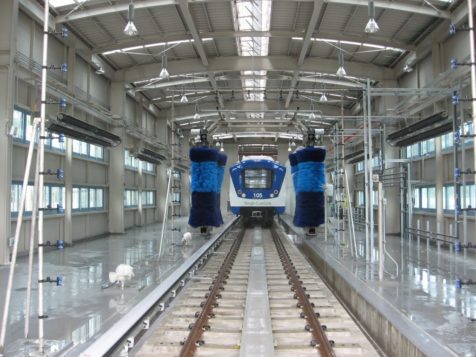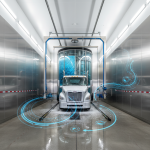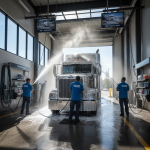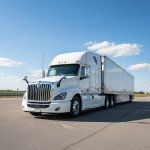If you’ve ever wondered what a transit wash system is and how it works, you’ve come to the right place. In this guide, we’ll provide you with a comprehensive overview of transit wash systems, including what they are, how they function, and their importance in maintaining cleanliness and efficiency in the transit industry. Get ready to dive into the world of transit wash systems!
What is a transit wash system?
A transit wash system is a specialized cleaning system designed specifically for vehicles in the transit industry, such as buses, trains, and trams. It is a mechanized system that uses various cleaning techniques, such as high-pressure water jets, brushes, and detergents, to thoroughly clean the exterior and interior of these vehicles. The main purpose of a transit wash system is to maintain cleanliness and hygiene, as well as to ensure the efficient operation and longevity of the vehicles. These systems are typically found in transit depots or specialized cleaning facilities and are an essential part of the maintenance routine for transit vehicles.
How does a transit wash system work?
A transit wash system works by using a combination of high-pressure water jets, brushes, and detergents to clean the exterior and interior of transit vehicles. The process typically starts with the vehicle entering the wash bay or cleaning area, where it is positioned in a way that allows for easy access to all sides of the vehicle. The high-pressure water jets are then used to remove dirt, grime, and other debris from the exterior surfaces of the vehicle. Brushes may also be used to scrub away stubborn stains or dirt. Detergents are often applied to help break down grease and other tough substances. The water jets and brushes are usually mounted on a system of tracks or gantries that move along the length of the vehicle, ensuring thorough cleaning of all areas. The interior of the vehicle can also be cleaned using similar techniques, with specialized brushes and nozzles designed to reach into tight spaces. Overall, a transit wash system is designed to provide a comprehensive and efficient cleaning process for transit vehicles, helping to maintain their appearance, hygiene, and operational efficiency.
Different types of transit wash systems.
There are several different types of transit wash systems available, each with its own unique features and capabilities. One common type is the drive-through system, where the vehicle drives into a designated area and the wash system moves around it, cleaning as it goes. This type of system is often used for larger vehicles, such as buses or trains, and can be very efficient for high-volume cleaning. Another type is the roll-over system, where the vehicle remains stationary and the wash system moves over it, cleaning one side at a time. This type of system is often used for smaller vehicles, such as vans or cars, and can be a more cost-effective option. Additionally, there are touchless systems that use high-pressure water jets and detergents to clean the vehicle without any physical contact. These systems are often used for delicate or sensitive surfaces, such as glass or decals, and can provide a gentle yet effective cleaning process. Overall, the type of transit wash system you choose will depend on factors such as the size and type of vehicles you need to clean, your budget, and your specific cleaning requirements.
Benefits of using a transit wash system.
There are several benefits to using a transit wash system for cleaning your vehicles. Firstly, these systems are highly efficient and can save you time and labor costs. With automated cleaning processes, you can clean multiple vehicles in a shorter amount of time compared to manual cleaning methods. This can be especially beneficial for businesses that have a large fleet of vehicles to maintain.
Secondly, transit wash systems provide a thorough and consistent cleaning. The automated processes ensure that every part of the vehicle is cleaned, including hard-to-reach areas. This helps to maintain the appearance and condition of your vehicles, prolonging their lifespan and reducing the need for costly repairs or replacements.
Another benefit is the ability to customize the cleaning process. Transit wash systems often have adjustable settings and options, allowing you to tailor the cleaning to the specific needs of your vehicles. Whether you need a gentle wash for delicate surfaces or a more powerful clean for heavy dirt and grime, these systems can accommodate your requirements.
Additionally, transit wash systems are designed to be environmentally friendly. Many systems use water recycling and filtration systems, reducing water consumption and minimizing the impact on the environment. This can be an important consideration for businesses looking to reduce their carbon footprint and operate in a sustainable manner.
Overall, using a transit wash system can provide numerous benefits for businesses that need to regularly clean and maintain their vehicles. From time and cost savings to improved cleaning results and environmental considerations, these systems offer a convenient and effective solution for vehicle cleaning.
Maintenance and care for transit wash systems.
To ensure the longevity and optimal performance of your transit wash system, regular maintenance and care are essential. Here are some key tips to keep in mind:
1. Follow the manufacturer’s guidelines: Each transit wash system may have specific maintenance requirements outlined by the manufacturer. It’s important to familiarize yourself with these guidelines and follow them accordingly.
2. Regular cleaning: Just like your vehicles, the transit wash system itself needs to be cleaned regularly. This includes removing any debris or buildup from the brushes, nozzles, and other components. Regular cleaning helps to prevent clogs and maintain the system’s efficiency.
3. Inspect for damage: Routinely inspect the transit wash system for any signs of damage or wear. This includes checking for loose or damaged parts, leaks, or malfunctioning components. Address any issues promptly to prevent further damage and ensure the system’s effectiveness.
4. Lubrication: Some parts of the transit wash system may require lubrication to function smoothly. Refer to the manufacturer’s guidelines to determine which parts need lubrication and how often it should be done.
5. Water quality: The quality of the water used in the transit wash system can impact its performance and longevity. If your area has hard water or water with high mineral content, consider using a water softener or filtration system to prevent mineral buildup and prolong the life of the system.
6. Training and education: Ensure that your staff members who operate and maintain the transit wash system are properly trained and educated on its usage and maintenance. This will help prevent any mishandling or improper care that could lead to damage.
By following these maintenance and care tips, you can maximize the lifespan and efficiency of your transit wash system, saving you time and money in the long run.




